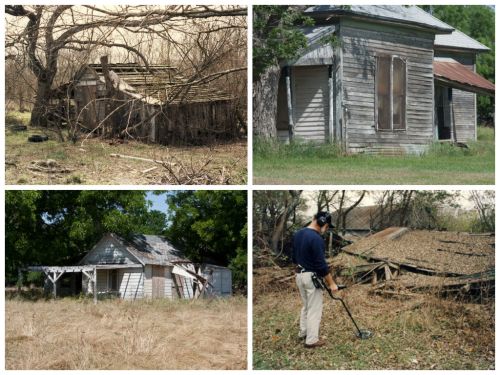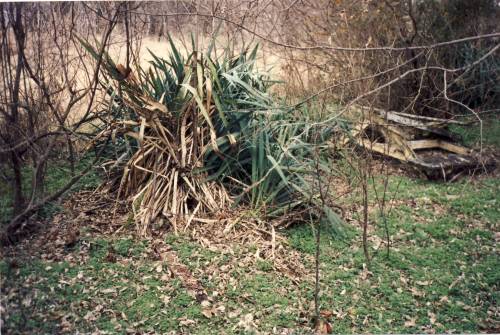Since I can’t wow you with my recent finds (there aren’t any) I will share another throwback from 2014.
Hope your holiday is going well and that your wine rack is full. From Fay and I….Merry Christmas!!
__________________
OLD HOMESITES
(May 2014)
I’ve always loved detecting old homesites and they are looking even better now given the influx of newcomers into the hobby. By the same token these sites can be a bitch to hunt. No two are the same and they are not always easily accessible. They also require a lot of patience and more than a few cans of ‘Off’. On a positive note…there’s always the possibility of uncovering a cache. A long shot for sure but you can’t rule it out.
An old homesite might simply an older home dating back many years that’s still being used. It could also be an abandoned farmhouse just down the road, overgrown, camouflaged and forgotten about. It could be that obvious depression in a field, a concrete slab in the middle of the woods or the stone remnants of a colonial cellar. What matters of course is that you find them before the competition does.
Early on I was able to locate older homesites by comparing early topographical maps with newer ones. I would lay them side by side and see if structures shown on the older maps were still on the newer one. If not that usually indicated it had been torn down, abandoned, burned or moved. It was a somewhat tedious and time-consuming exercise, but was well worth my time, especially on a rainy day or during the winter months.
I then discovered an easier way thanks to a close friend who happened to be an avid hunter. He knew of my passion for detecting and told me about a couple of stone foundations he had stumbled upon while tracing through the woods. They wound up being old cellar holes and provided me with quite a few neat finds. At that point I started asking other hunters, as well as neighbors and farmers and found there were more cellar holes no more than a half mile from my front door.
A more direct method would be to get in your car and drive the back roads, looking for clues….a noticeable open area in a grove of trees, an overgrown lane that appears to go nowhere or trees, shrubs and plantings that are foreign to the rest of the vegetation (they didn’t just magically appear there).
OKAY, YOU’RE THERE…NOW WHAT?
Once you’ve located an old homesite site and ready to hunt, try to determine what the layout might have been years ago. If only a cellar hole exists, imagine if possible where the entrance might have been and then look for the outhouse and any traces of outbuildings, root cellars or trash pits.
Root cellars might be very obvious or nothing more than depressions in the ground. I’ve found trash pits the easiest to locate thanks to the heavy concentration of signals and while it may not always provide you with the best of finds, it offers the potential of very old and sometimes very rare bottles if you are willing to get down and dirty. Careful probing and delicate excavation are prerequisites to bringing them home in one piece
Always search a homesite as you would your home. Concentrate your efforts on the traffic areas…where people entered, exited, and where they may have worked and played. Where did they hang their clothes to dry? Where was the well?
Lastly if you are an impatient tekkie find some other place to search. Old homesites will not be your cup of tea. You will have to deal with lots of iron, trash and you will need to dig all of it to come out a winner. I once was asked to hunt an old homesite in New Jersey by a son and daughter who knew their recently deceased father had a large coin collection. They couldn’t find it and were pretty sure he had buried it. Anyway once I got there it didn’t take me long to realize that if I was going to find it I would have to dig every signal that came my way. I spent days searching for those coins but never found them. I did however wind up with a pile of trash that was up to my knees. Machine parts, rusty cans, nails, you name it.
CACHES? DO THEY EXIST?
So…do I believe caches exist? You bet and I believe they exist in greater numbers than we think. They exist because homesteaders, early settlers and landowners did not have easy access to banks and even if they did many did not trust them. Giving your life savings, no matter how meager, to someone else to mind was unsettling (still is today). As a result old-timers hid their savings, their pin-money, their drinking money and passed away without telling anyone where.
The premise I go on with every old homesite is that there is a cache hidden somewhere on the property and looking for it is not only worth my time, it’s fun. It becomes an added challenge and while I may not find it, it doesn’t mean it doesn’t exist. It might simply mean that I wasn’t clever enough to find it!!
Post hole banks were very popular hiding places years ago….pull out a fence post, put in your money and replace.
When looking for a cache, always start with “If I lived here…where would I hide something”? In other words where would YOU secrete your life savings and feel confident that no one would discover it? Would you hide it inside or outside? If you buried it would you do so away from the house or would you bury it so that you could keep an eye on it while inside? Also, if you buried it, how deep would you dig…one foot, two feet….five, six? The questions you can ask yourself are endless, but they just be the same ones asked the individual doing the hiding and you will at least have some idea on where to concentrate your efforts.
Whether you find a cache of coins or not an old homesite will offer a lot of neat finds. Coins, buttons, old bottles, relics, and antiques just to name a few. I strongly recommend searching in the all-metal mode, and accept the fact that you will dig a lot of trash. Who knows what sort of container Jethro used to bury his stash. Slow down and dig ‘em all.
Where should you begin to look for a cache? Consider the following:
- In fireplaces…check for loose bricks or river stone
- Under front porches
- In root cellars
- Under large trees
- Under fence posts
- In hollow window and doorsills
- Under floorboards
- In old abandoned autos
- In barns or out buildings within site of the house
- In outhouses
- In attics
- In cellars (especially with dirt floors)
- In canned food containers…along with actual foods
- Under woodpiles
- In chicken coops
- In barn lofts or roof beams
- In hollowed stairs
- In pipes and drainage systems
- In old tree stumps
- Under sidewalk stones
- In farm equipment
- Under unusual markers or stones
- In hollow light posts or lanterns
- In planters or pots
- In stacked stone boundary walls
If old homesites intrigue you be sure to check out Todd Hiltz’s videos. He and his partner Dave Wise are real experts…..
_______________












Probably our favorite type of detcting,old homesites, pre1920 if lucky.Anything after that is tough going and time consuming mainly because farmer usually used as a trash pit or more modern plumbing and electrical was strewn about when demoed. Occupants post 1920 had a lot more modern bldg material and items.Sometime helpful to move surface trash away and cherry pic high tones with a small coil. I especially like when the research really works out locating pre 1900 sites. I like to use 1800’s map to locate site then look at historical aerial photos which started around 1930 to current. The sites that most interest us are the ones that don’t show up as occupied on aerials but are on old map.Working on one now Dick outside of lambertville, wertsville rd.This is the best time of year for locating,foilage is down and ground not quite frozen.
A MERRY CHRISTMAS and happy new year to you and your family Dick. Brian Obitz.
Hey Brian, good to hear from you and thanks for the tips. Miss the old stomping grounds….
Hope you and the family have a happy…
Good advise. Hope y’all have a Merry Christmas.
Thanks Paul and a Merry Christmas to you and yours..
Merry xmas Dick! Thanks for the great article on old homesteads.You are correct in stating
that one needs the “patience of job” to hunt them. Entering ‘winter phase” now. Time for research,research,research.
(h.h.!)
j.t.
Thanks John. Merry Christmas to you as well. Have one for me…
WOW Dick,
NOW you are right up my alley on this post! I have been hunting old homesites as my primary hunting grounds about 35 out of my 45 years of hunting. Used to be I would do as Charles Garrett said, and find “Old Timers” in small towns and spend some time learning what they knew about the locale I was wanting to hunt.
I have been blessed with finding 3 caches in my life. The first I accidentally found while I was at an old homesite that had burned and killed the family in 1901. Found them in a microfiche newspaper, at the library. I was looking for coins, but got a good signal that ended up being a mason jar lid, on a broken mason jar, that held just a bit over $20 in pre-1900 coins. I remember thinking, if there is one….well, I kept hunting that site, and after 6 trips there, I was hunting along an old fence line, and I saw a fence post on the ground, and all the wire nails, tho rusty, were clipped off, which would allow someone to unhook the wire from the post…My heart started racing, as that was one of the signs I had learned to look for.
Since the post was lying flat on the ground, I figured to search around the area near where the base of the post was. 25 minutes later, but only about 8 feet from the post, I got a signal that was a strange one. But as you say, you gotta dig them all!. At just over 1 foot, I uncovered the top of an old ceramic container…and inside, there was $323.81, ALL in pre-1900 coins. Among the trove, I found not one, but TWO $20 gold coins. I forgot about the rest of the coins….just junky old silver, and I spent about 30 minutes, hands shaking, salivating over the gold. LOL And another hour plus getting the container out intact. I don’t know if it was my excitement, or the reality, but that thing was HEAVY. I didn’t want to leave it to take it back to my car, so I carried it first, put it in the trunk, looked around all over, and then went back and got my detector.
Sorry for the long memory…
Today, I normally use a 1-2-3 punch to find my old homesites. I use my old topo maps, and perform an overlay on Google Earth to find the old sites that are no longer there, and then I use OnX maps, with my GPS coordinates from Google Earth, and I get the owners contact information….and I go from there, usually knocking on their doors and asking permission.
I have a fourth punch, which you and I spoke a bit about, my thermal camera drone. I can sure scout the area I am in, along with getting down if I see something of interest. Back in 1973 when I started detecting, the old timers still were there, and it took legwork to get to the old homesites. Now, I AM an old timer, and I can sit in my easy chair, find exactly where I want to go, and drive right up to it most of the time…..or close enough so that I can walk without gettin down in my back, and spend a few hours looking for another cache….but dang it all to heck…somewhere along the line, I have had to give up digging every signal…ahhhh, here’s to the Glory Days Brother!, as I hoist a glass of applejuice, as I gave up my wine a long time ago…..HH, even if it is only in our memories….
Hey Dennis, long time….
That was a nice haul. Wish I could say I found something like that but nada. No gold coins and despite finding a helluva lot of old silver I’ve never found a silver dollar.
And yes indeed those were the Glory days. Hope your holidays are great and your new year a healthy one.
Lots of backwood folks would hide coin caches in metal cans. Many would cut a small hole large enough to evacuate the contents and sometimes another slot to slip coins thru. These could be hidden in plain sight inside a barn up on beams. Need the money, take the can down, cut it open and head for town! Forget how many cans you hid in the ground and some would never be recovered.
One thing to learn is that metal detector eddy currents do not penetrate a rusted metal can. If you are a “cache hunter”, you are not using any discrimination, you are reducing your sensitivity to avoid small iron and listening for signals much wider than your large searchcoil width in a true all-metal mode!
Hi Bob,
Thanks for the additional tips….happy holidays and you can have the snow.
Merry Christmas Dick. I enjoyed this post but sadly I haven’t been to an old homesite in awhile. Thanks to the other folks on the tips of finding them.
You too Tony. Have one of those top shelf single malts for me….
And don’t forget orchards! This tip is free and does not incur a payment of $20.00. (just in case you were thinking of mailing me said amount).
Your Limey ‘Pal’….
Not to worry…the “just in case” thing never entered my mind.
Great article Dick with a lot of fantastic information and tips. I have detected for many years but never put any emphasis into old homesteads. I think that might change now. I wish you and your family a very Merry Christmas.
Thanks Todd. Sadly, old homesites/rural areas might be the last frontier for us. Hope not…
Merry Christmas!
Good post Dick. I’ve found a few caches, and the thrill is great. I read somewhere that one in five old homes has a buried or secret cache someplace. Most new folks in the metal detecting hobby have no idea they even exist. And i agree, trying to puzzle out where one might be is a hoot! Merry Christmas Dick, both you and Fay have a very Happy New Year!
Thanks Jim and a Merry Christmas to you and Patti as well…..